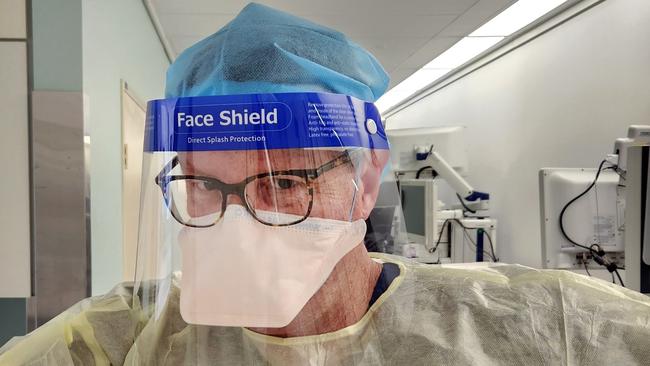
Although much of the pandemic remains a blur for me, one birth in particular remains fixed in my mind. We were performing an emergency caesarean for a woman who was ill with Covid. The poor woman was not allowed to have her partner with her. Every person in the operating room was wearing full protective equipment and all were exhausted.
For the theatre team to identify each other under the layers of protection we would write our names in Texta on our face visors. From the perspective of the mother-to-be, it must have felt like an alien abduction in a science-fiction movie. All of us were doing our best to humanise the experience and somebody asked what she intended to name her new baby.
She looked around at the people surrounding her on the operating table, then said through her thick mask, “Well, I don’t like any of the names you lot have written on your masks, that’s for sure.”
It was a rare and welcome moment of humanity in what were difficult times.
Performing medical tasks with full infection-control procedures and outfits made everything difficult and slow. With large numbers of clinical staff furloughed due to illness or exposure, people were working long hours. Tempers were fraying and people were, at times, exasperated.
Maternity care was one flashpoint, but there were many across our hospitals. With remote antenatal visits, there was a sense that complications might be missed and staff were upset about this. Men often were angry with staff because they felt their pregnant partners were being ignored, or that births were delayed, or that nobody cared. Yet everyone cared so much – and everyone just wanted it to be over.
When the Covid-19 pandemic was declared in Australia five years ago, nobody had any sense of where or when things would end. Near-apocalyptic images were beginning to emerge from overseas and an atmosphere of fear and doubt descended across the national consciousness. It became obvious quickly that there was no playbook for dealing with the rapidly spreading wave of infection.
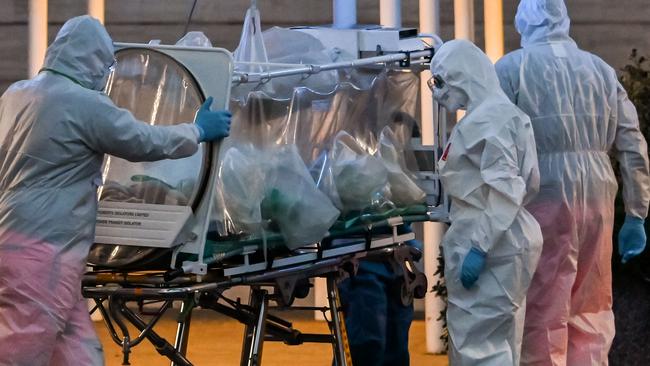
Those early images from overseas were horrifying. As the gravity of the situation became clear, healthcare workers across the country realised they would soon find themselves in the eye of the storm. Paramedics, nurses, medical technicians, doctors … Australia’s hundreds of thousands of health professionals knew from the earliest days that they would need to step up. Everyone had a sense that they would have to give their all for the community.
As we survey Australia’s health system five years later – across our public hospitals, primary care clinics and even our struggling private sector – much of what we see can be traced back to events set in motion in the early days of the pandemic. Premature retirements and career changes, disillusionment and dismay, much of the disorder and dysfunction in our health system is a legacy of the pandemic.
Australia has a world-class healthcare workforce, but managing highly infectious disease requires experience, skill and special training. The teams who provide such expert care for contagious patients practise their craft regularly and know the ropes, so to speak. Other healthcare groups – those managing surgical cases, injuries, cancer or other chronic conditions – are good at what they do, but often have little experience with respiratory infections.
Like so many of my colleagues, I had to learn the basics again. How to put on the restrictive protective gear, how to undertake challenging and delicate tasks with a mask fogging up from sweat, and how to take it off safely and not infect yourself and the people around you. That is, if you could get hold of the protective equipment in the first place. In many hospitals that was not guaranteed, especially outside of our major centres.
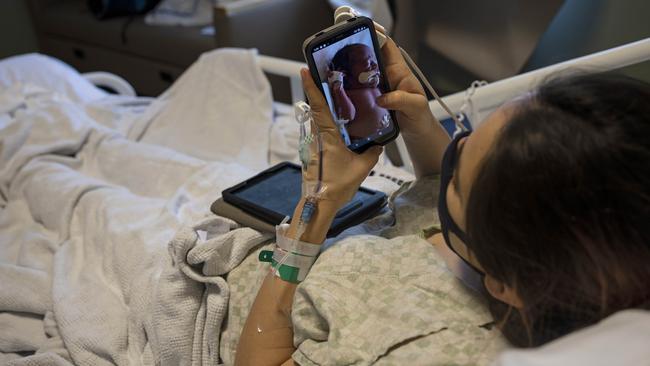
One of the reasons that non-urgent planned surgery was cancelled across the country was that the protective equipment required – gowns, masks, gloves – was in short supply and would likely be needed to care for Covid patients. The surgical teams also would be needed as a back-up workforce to undertake other tasks and provide help as nurses and doctors themselves were exposed to the infection.
With the cessation of planned surgery across the country, teams that had perfected the craft of surgery suddenly found themselves out of their depth trying to learn new skills and transplant these to other areas of their hospitals. Trainees in surgery were suddenly faced with not having any operations to train on. Nurses with consummate skill in perioperative care were fumbling with new tasks they were ill-equipped for.
Like so many highly experienced healthcare workers across the country, I found my own work in maternity care turned on its head. A time that should be one of intimacy and close contact during birth would become a hell for many women. Midwives and doctors were doing their best to provide routine and emergency care while shrouded from head to toe like medieval knights.
Partners could not visit. Babies were isolated. Women who developed Covid infection during pregnancy and – worst of all – at the time of birth were denied the affirming experiences they expected. Babies became infected. Fear permeated the atmosphere as new parents fretted over the effects of the coronavirus on their newborns.
So it went across all of the health system. Tasks that normally were routine became exercises in horror for patients, their families and loved ones, and the staff providing that care. Many routine tasks, such as cancer screening, were put on the back burner and the staff were well aware. The long tail of this enforced neglect continues to play out, with long waits for medical procedures.
I know of many colleagues – doctors, nurses, and other healthcare workers – who had been toying with retirement and took that step during the pandemic. Others were so affected by the experience that they made career changes or took extended breaks to consider their future. Those who continued to work were burnt out and never went back to the long hours they used to put in at their hospitals and clinics.
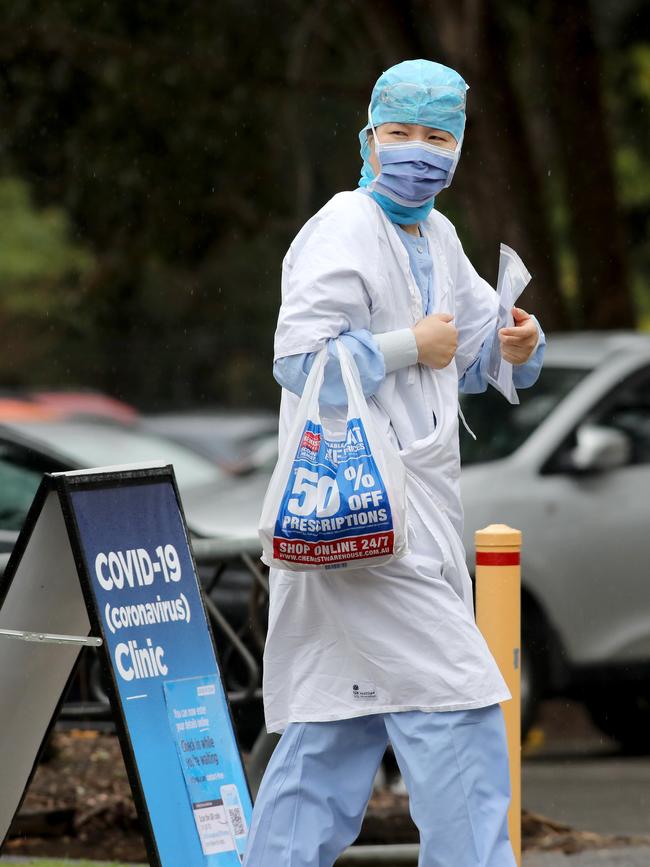
For many people things were made even worse by disgruntled and often aggressive malcontents who menaced staff or harassed nurses on the way home from exhausting shifts caring for the sick and dying. Social media was full of threats against those who administered vaccines. Protesters milled around outside of hospitals, accusing the staff of being part of some vast conspiracy. It would be laughable if it hadn’t caused so much distress to so many dedicated professionals who had given everything they had to the system.
In the phase before arrival of the first vaccines, many healthcare workers were infected and a number succumbed. Nurses were isolated from their families, fearful that they would pass on infections they had acquired working with the sick. Healthcare workers’ children were home from school while their parents struggled in the system. The burden became overwhelming for many nurses and others.
It is easy to envision the pandemic as one affecting only our public hospitals. That is certainly not the case. Paramedics were transporting ill patients. Aged-care facilities were affected, often severely. The community care of the mentally ill – a group at particular risk of serious infection – was thrown into chaos. No corner of the health system was spared.
Australia’s general practitioners have been at the frontline of healthcare for decades. They carry an enormous burden that often is poorly understood, not only by patients but by politicians and health bureaucrats. Any person who sits in front of a GP could have something seriously wrong with them. It is the responsibility of the GP to make that call, to identify the person at risk from the dozens who are healthy.
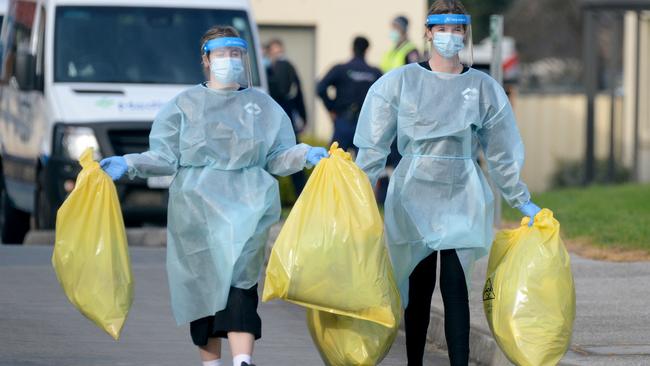
Adding the layer of Covid over the top of routine healthcare made work almost intolerable for many GPs. Traditionally responsible for preventive tasks such as immunisation and health screening, as well as providing care for chronic conditions such as diabetes and depression, GPs found themselves trying to undertake all of this routine care while managing potential Covid cases as well.
General practices had little control of who walked through the door, and the vast majority were not set up to the infection control standards required for the pandemic. Many GPs felt as though they had been forgotten or abandoned. To add insult to injury for many, they had little access to the personal protective equipment necessary to safely assess and treat patients. The pandemic was an isolating experience for many of our GPs and their staff as they battled to provide the best care possible.
Today we survey a health system still recovering from the pandemic. Staff are scarce and many describe themselves as broken, for many their mental health shattered. There are long waiting lists for procedures that could not be done during the pandemic. Emergency departments struggle to cope with demand. All the while, Australia’s healthcare workforce contemplates what health-system shock might strike them next.






